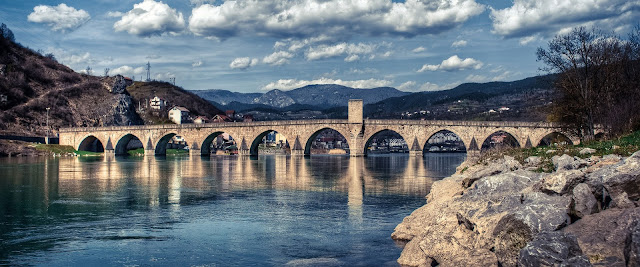Blog 13: Visegrad & the dark hidden secrets of the Bajna Basta hydro-electric dam
Visegrad & the dark hidden secrets of the Bajna Basta hydro-electric dam
Very in the beginning of the Bosnian war the Serbs already started with massacres and ethnic cleansing in East Bosnia which ultimately ends in the Srebrenica massacre. During the Bosnian war I had never the opportunity to travel through East Bosnia, but presently it is safe to pass the former war zones between the Serbian and Bosnian parts. Only some signs are presenting that we passed the former battle zones.
Visegrad
The Višegrad Bridge was commissioned by Grand Vizier Mehmed Paša Sokolović, who exercised power over a long period at the summit of the Ottoman Empire during the reign of three sultans as a tribute to his native region and a symbol of trade and prosperity. Construction of the bridge took place between 1571 and 1577. Major renovations of the bridge have taken place in 1664, 1875, 1911, 1940 and 1950–52. Three of its 11 arches were destroyed during World War I and five were damaged during World War II but subsequently restored. The bridge received UNESCO World Heritage Listing in 2007.


The “Bridge on the Drina” is also a historical novel by the Yugoslav writer Ivo Andrić about this bridge building. It revolves around the Mehmed Paša Sokolović Bridge in Višegrad, which spans the Drina River and stands as a silent witness to history from its construction by the Ottomans in the mid-16th century until its partial destruction during World War I. The story spans about four centuries and covers the Ottoman and Austro-Hungarian occupations of the region, with a particular emphasis on the lives, destinies and relations of the local inhabitants, especially Serbs and Bosniaks.
In 1961, Andrić was awarded the Nobel Prize in Literature and his works became subject to international recognition.
In 1961, Andrić was awarded the Nobel Prize in Literature and his works became subject to international recognition.
The dark hidden secret of the Drina and the Bajna Basta Lake
However the Drina river is still hiding the dark side of the Bosnian war. According to the survivors of the massacres in the beginning of the Bosnian war the Drina river was used to dump many of the bodies of the Bosniak men, women and children who were killed around Visegrad and were killed on the famous Mehmed Paša Sokolović Bridge. Day after day, truckloads of Bosniak civilians were taken down to the bridge and riverbank by Serb paramilitaries, unloaded, shot, and thrown into the river.
In July and August 2010, when the level of the reservoir waters behind the Bajna Basta hydroelectric dam downstream in the Drina was lowered while maintenance and repair work was being done on the dam, the remains of many civilians who perished in the Višegrad massacres in the early days of the Bosnian war, were discovered. It is believed that there were over 2,000 bodies in the lake, making it one of the largest mass graveyards in the Balkans. As of 23 September 2010 remains of 373 bodies, believed to be mostly those of victims of the Višegrad massacres, had been retrieved from the reservoir, which was due to commence refilling on 26 September. Many volunteers joined the official teams searching for the bodies but the Serbian authorities were insistent that the dam was brought back into service and refilled before the recovery work was complete. It is terrible, frustrating and unbelievable that the electricity price is dominating the retrieving of the remaining bodies.
However the Drina river is still hiding the dark side of the Bosnian war. According to the survivors of the massacres in the beginning of the Bosnian war the Drina river was used to dump many of the bodies of the Bosniak men, women and children who were killed around Visegrad and were killed on the famous Mehmed Paša Sokolović Bridge. Day after day, truckloads of Bosniak civilians were taken down to the bridge and riverbank by Serb paramilitaries, unloaded, shot, and thrown into the river.
In July and August 2010, when the level of the reservoir waters behind the Bajna Basta hydroelectric dam downstream in the Drina was lowered while maintenance and repair work was being done on the dam, the remains of many civilians who perished in the Višegrad massacres in the early days of the Bosnian war, were discovered. It is believed that there were over 2,000 bodies in the lake, making it one of the largest mass graveyards in the Balkans. As of 23 September 2010 remains of 373 bodies, believed to be mostly those of victims of the Višegrad massacres, had been retrieved from the reservoir, which was due to commence refilling on 26 September. Many volunteers joined the official teams searching for the bodies but the Serbian authorities were insistent that the dam was brought back into service and refilled before the recovery work was complete. It is terrible, frustrating and unbelievable that the electricity price is dominating the retrieving of the remaining bodies.




Comments
Post a Comment